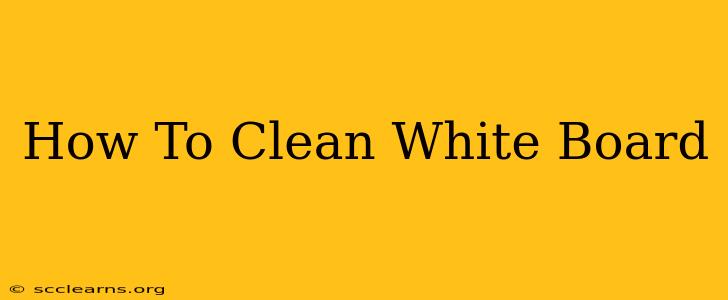Maintaining a clean whiteboard is crucial for a productive workspace, whether it's at home, school, or the office. A dirty whiteboard not only looks unprofessional but can also impact the quality of your writing and presentations. This comprehensive guide will walk you through the best methods for cleaning your whiteboard, ensuring it stays pristine and ready for your next big idea.
Understanding Your Whiteboard's Material
Before diving into cleaning techniques, it's important to know what your whiteboard is made of. Most whiteboards are either porcelain steel or melamine. Knowing this helps you choose the right cleaning method to avoid damage. Porcelain steel boards are generally more durable and resistant to scratches, while melamine boards are more susceptible to damage from harsh chemicals and abrasive cleaners.
Essential Cleaning Supplies
Gather these essential supplies before you begin:
- Microfiber cloth: This is your best friend for whiteboard cleaning. It's gentle enough to avoid scratching the surface and effectively lifts away dirt and marker residue.
- Warm water: Often, plain warm water is enough to clean a mildly dirty whiteboard.
- Whiteboard cleaner (optional): Commercial whiteboard cleaners are available, but make sure they're specifically designed for whiteboards to prevent damage. Always test any new cleaner on a small, inconspicuous area first.
- Soft sponge or eraser (for stubborn marks): For those persistent marker stains that refuse to budge, a soft sponge or a melamine foam eraser can be helpful. Avoid abrasive sponges or scouring pads.
- Glass cleaner (for occasional use): For truly stubborn stains or a deep clean, a streak-free glass cleaner can help, but use sparingly.
Step-by-Step Cleaning Guide
Here's a simple step-by-step guide to cleaning your whiteboard:
-
Prepare the surface: Erase any existing writing with a whiteboard eraser. Make sure to remove all traces of marker.
-
Dampen the cloth: Dip your microfiber cloth in warm water and wring it out thoroughly. The cloth should be damp, not soaking wet.
-
Wipe the surface: Gently wipe the entire whiteboard surface with the damp cloth, working in a smooth, consistent motion.
-
Address stubborn marks: For stubborn stains, use a soft sponge or melamine foam eraser, gently rubbing the area until the mark disappears. Avoid excessive scrubbing, which can damage the board. If the stain persists, apply a small amount of whiteboard cleaner to a clean section of the cloth and gently rub the affected area.
-
Dry the surface: Once you've removed all marks and residue, use a clean, dry microfiber cloth to wipe the entire surface again. This ensures a streak-free, shiny finish.
-
Optional final polish: For an extra-sparkling clean, you can use a very small amount of glass cleaner on a fresh cloth, buffing the surface gently. Remember, less is more to avoid streaks and damage.
Tips for Maintaining a Clean Whiteboard
- Clean regularly: The key to a clean whiteboard is regular maintenance. Wipe it down after each use to prevent marker residue from building up.
- Avoid harsh chemicals: Never use abrasive cleaners, ammonia-based products, or bleach on your whiteboard. These can damage the surface and leave streaks.
- Store markers properly: Always replace the caps on your markers to prevent them from drying out. Dried-out markers are harder to erase and can leave stubborn stains.
- Use the right markers: Use markers specifically designed for whiteboards. Using other types of markers can lead to difficult-to-remove stains.
By following these simple steps and tips, you can keep your whiteboard clean, functional, and looking its best. A clean whiteboard equals a clear mind and a more productive work or learning environment.

